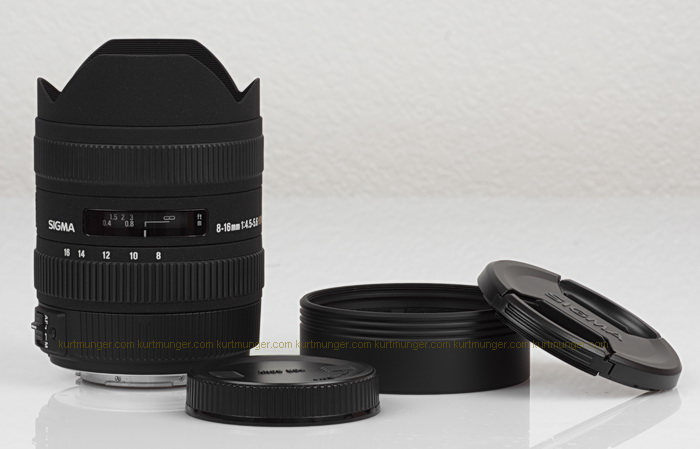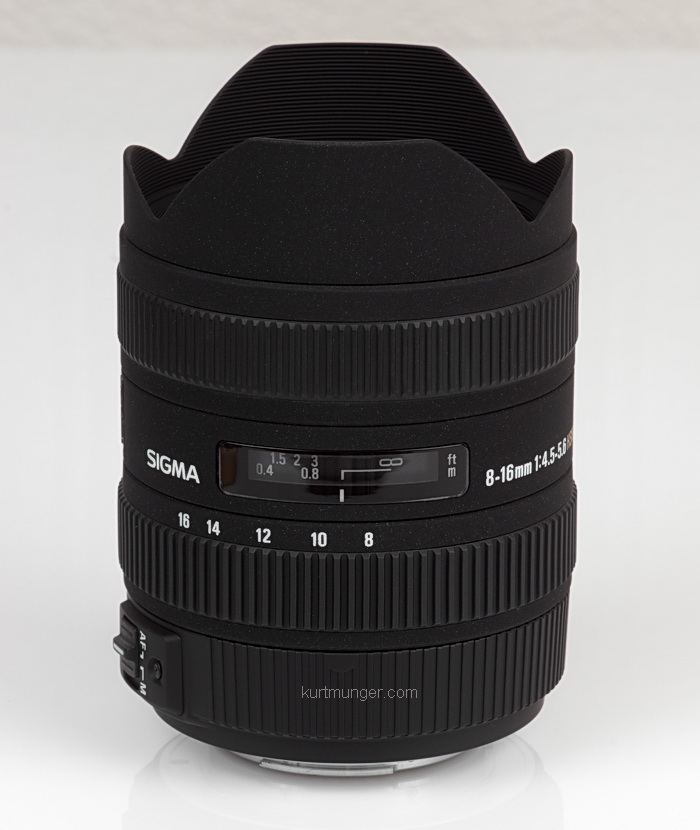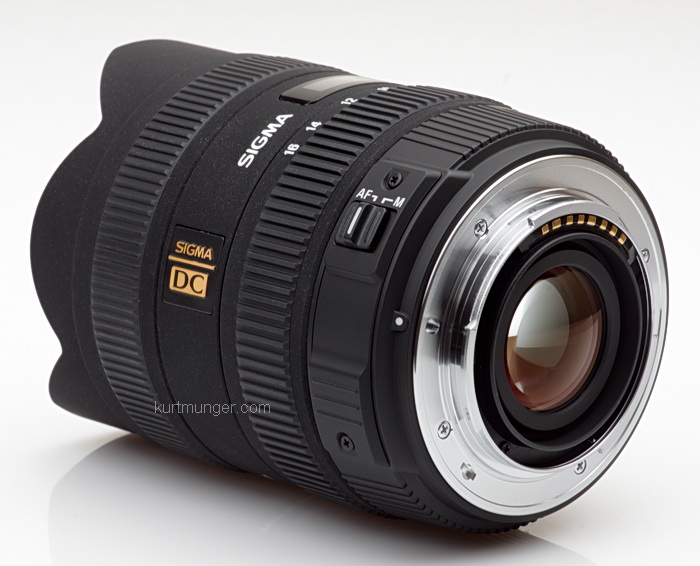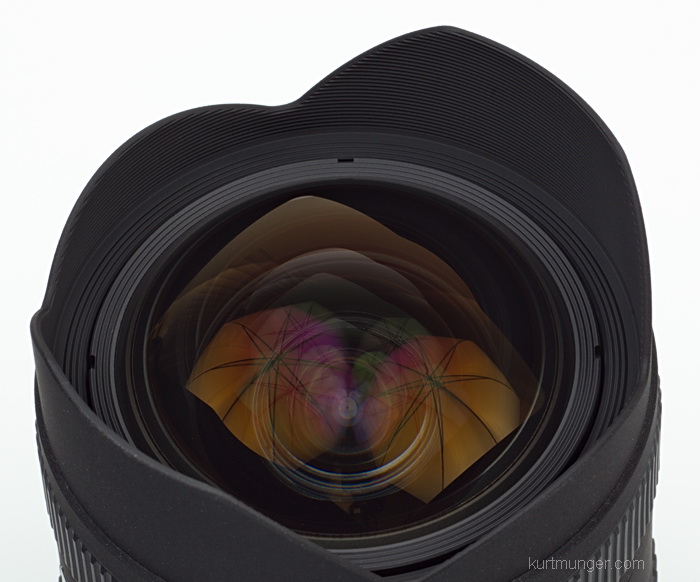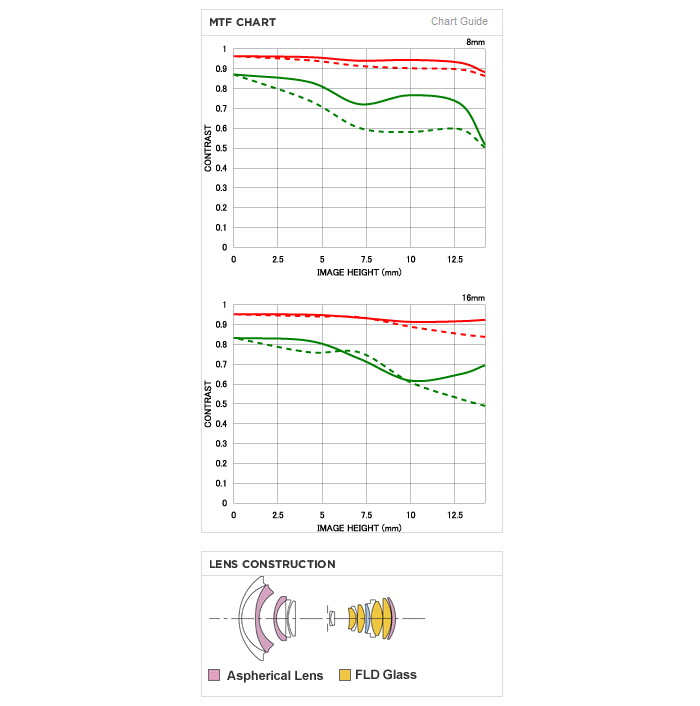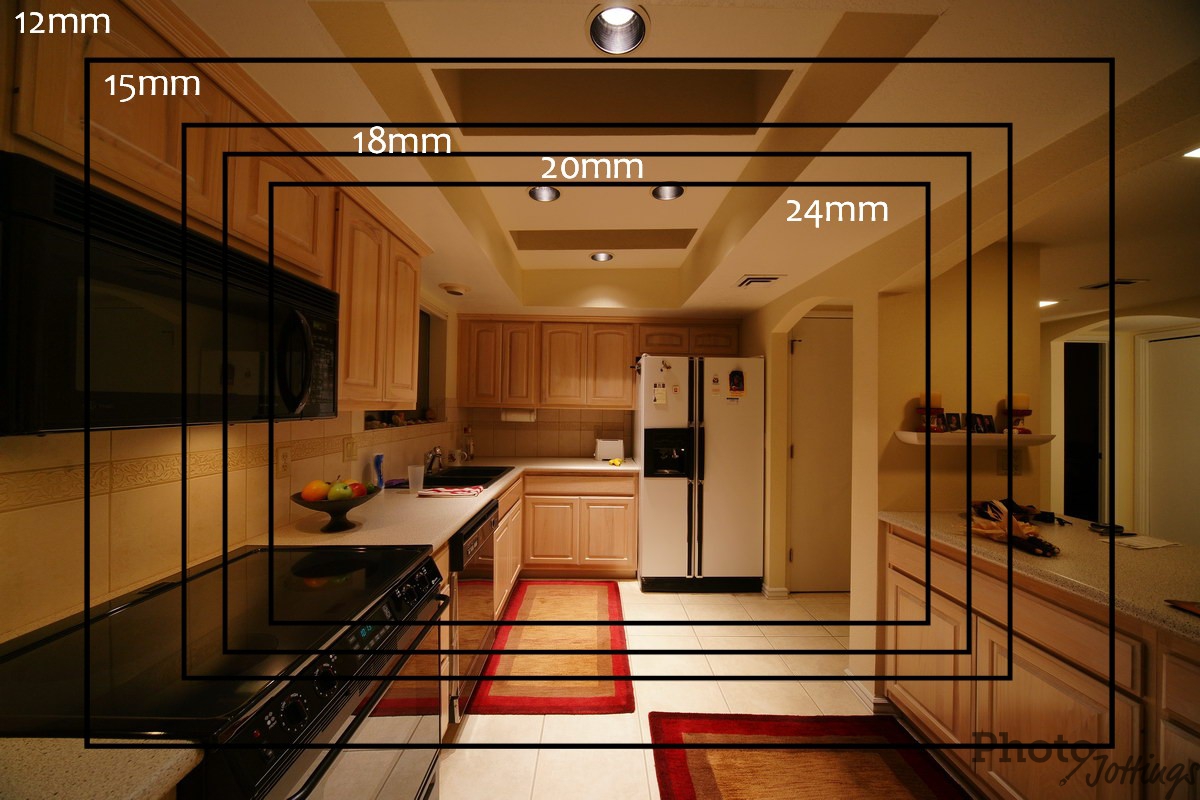|
Full review of the Sigma 8-16mm F/4.5-5.6 DC HSM lens. The Sony A580 was used for this review. For a better understanding of terms and methods used in this review,go here.
The usual center, mid-section and corner crops are located at the very bottom of the page.
Introduction.
Sigma now offers an APS-C ultra-wide zoom that has the same focal range as the full frame Sigma 12-24mm F/4.5-5.6 I reviewed a few years ago. This downsized version includes Hyper-Sonic Motor (HSM) focusing, a different optical formula, no rear gel slot (that comes with the full frame version), and neither one can use screw-on filters because of the bulbous front elements and built-in hoods.
The Sigma 8-16mm F/4.5-5.6 DC HSM has a very good build quality, with a mix of metal and plastic, and unfortunately has the standard sparkly rough black finish you see on many of Sigma’s other lenses. I don’t care for this type of look, but oh well. This lens sports a focus distance window, (no DOF scale), a rubber ribbed manual focusing ring at the front, a rubber ribbed zoom ring at the back with focal length marks at 8mm, 10mm, 12mm, 14mm and 16mm. Also included is an AF/MF switch on the left side to turn off the HSM. Sigma claims the use of a whole bunch of fancy hybrid/FLD type elements in the design of the lens. This Sigma model is ‘made in Japan’.
Zooming from 8mm to 16mm causes the front optical group to drop about 3/8″ or 8mm.
Avoid setting the lens down on the mount side without the cap at 8mm because the very curved rear element sticks out and will touch the surface and wobble around.
Don’t try using this on your full frame camera without APS-C size capture on, it vignettes hard at 16mm, and at 8mm blocks about half the image.
The 8-16mm focal length seemingly covers the same area as 12-24mm on a 35mm film or full frame digital camera, but in reality, the 12-24mm has slightly wider coverage. EXIF focal length data reads correctly at the index marks for 8mm, 10mm, 12mm and 16mm. At the 14mm mark the data reads 15mm, just like the other super wide zooms I’ve tested; there is no 14mm in the data at any zoom setting, in fact, I’ve never seen 14mm in the EXIF data on any super-wide zoom.
In the box is the lens, front and rear caps with adapter, soft case, and owner’s manual. The front cap is a standard Sigma 72mm.
Focusing. This lens has a quiet ‘HSM’ motor inside to provide focusing, (similar to Sony’s SSM, but not SAM). All focusing is done internally. The focusing ring turns about 130°, which allows precise manual focusing, although my copy is aggressively damped, so it’s almost too hard to turn with one finger. Focusing seems pretty accurate, and that’s unusual for a zoom lens this wide.
Cleaning. Do not clean this lens by using a blower bulb/brush on the front or rear elements, there are gaps in both, and you could wind up shooting dust inside the lens. Use a proper cleaning cloth and carefully wipe the front element with the zoom between 8-10mm, or in the ‘up’ position.
Requisite product shots.
General information and specifications.
Optical qualities summary.
Lens flare/ghosting. About average control. I sometimes see some small green/magenta blobs in the image when the sun or bright lights are near the edges, or inside the frame, see examples below. Flare is sometimes heavy with the sun at the very edges of the image.
Light fall-off. Moderate amount at 8mm, F/4.5, and minor as you zoom out. See samples below.
Color fringing (CA). Lateral color fringing control is average to above average for an ultra-wide zoom. I see minor magenta and cyan along the edges of the image at all focal lengths, but mostly at the long end, or 16mm. See example in the sharpness crops at the bottom of the page.
Bokeh. Fairly harsh at all apertures and lengths. Getting background blur is not easy at 8mm. See examples below.
Color. Seems about the same as Sony lenses.
Close up filter. N/A
Coma. None.
Regular filters will not accept filters.
Filter size. Due to the bulbous front element and built in hood, you can’t use filters.
Distortion. Minor to moderate barrel and pincushion, depending on focal length, see samples below.
The distortion pattern changes as you zoom from 8-16mm. I see moderate to heavy barrel distortion at 8mm, becoming less at 10mm; at 13mm it flattens out some, but gets a little wavy, and by the end of the zoom it shows some minor pincushion.
Bokeh samples.
Bokeh looks somewhat harsh at all zoom lengths, having a hard outlined edge, however, it’s hard to get any background blur (especially at 8mm!) unless you focus on something very close. Bokeh is out of focus highlight blur, and not simply how far out of focus the background is. Light fall-off samples.
light fall-off is not a problem with this lens, especially as you zoom out.
Flare and ghosting.
Ghosting control is generally good. When the sun is in the image a green spot and amber/orange colored blob might be visible, especially against a dark colored background. When stopped down hard, like F/11-22, ghosting is much more noticeable. Use your hand to block bright light sources when they’re out of the image, but be careful not to get your hand in the image!
Coma samples
Coma takes the form of weird, smeared blobs at points of light in the corners of the image, especially in super wide angle lenses. Coma in not a problem with the Sigma 8-16mm F/4.5-5.6. 100% crops from the far corners.
Aperture/focal length guide for the Sigma 8-16mm F/4.5-5.6 DC HSM
Let’s check out the macro capabilities of this lens.
The sample shot was taken with the Sony A 580 16.2MP camera, so don’t compare it with some others that were taken with the 12.2mp A700. The subject is a standard US stamp, 0.87″x 1.0″ or 22mm x 25mm. Also, note the macro shot was taken as close to the subject as focusing allowed; in this case a very short 2.5″ (63mm), measured from the front of the lens barrel (permanent hood) to the subject.
I see a somewhat small (0.13x) shot, (click for full cropped image, 269k), from F/5.6-F/8. It does seem to lack some contrast, but shows good detail. As a side note; the “1996” on the bottom left of the stamp measures a mere 1mm wide.
Cap adapter issues.
The included adapter cap has 72mm filter threads at the end to give the pinch type cap something to grab, and you can put a standard 72mm filter on the end, but this is what happens. You could to this for effect, but I’d rather do it in post processing to avoid wrecking the image in case you change your mind.
Capture area guide below.
This is the same image I used a couple of years ago in the Sigma 12-24mm review to show how much coverage you get between 12mm and 24mm. In our case, the 8mm end of the APS-C Sigma is basically the same as the full frame 12mm, and 16mm is the same as 24mm. Don’t use the wide end of this lens for any serious interior photography, it’s too hard to light properly, and it looks funny, like this image.
Conclusion
The Sigma 8-16mm F/4.5-5.6 DC HSM ultra-wide zoom is a specialty lens, meaning it will probably appeal to a rather small segment of people that really want wide, and I mean shoes-in-the-picture wide! This lens (at the widest focal lengths) begs to be jammed in the middle of an interesting plant or work of art, or taking non-traditional views of urban environments. Folks wanting this type of lens should not be too concerned about the technical image quality, and instead focus their interests and efforts on effective composition. If you want a really fun ultra wide lens, check this one out.
If you’re really concerned about the image quality of the lens, here’s my take: it’s very sharp over most of the frame at F/5.6 between 8-10mm; around 12-16mm the mid-sections and corners don’t quite match the centers, but the performance is still very acceptable. Light fall-off is very low, ghosting control is slightly above average in most cases, color fringing control is average for this type of lens, and overall handling is quite good. The distortion pattern is typical of this class of zooms, and is mostly correctable in post processing. I found the auto-focusing to be very accurate, which is unusual for an ultra-wide zoom lens.
This is not a very good interior/Real estate photography lens because it’s simple too wide over most of the zoom range. Try properly lighting a room when using 8mm, it’s basically impossible. Plus, the exaggerated view just doesn’t look believable. If you want to sell your photography to an architect, interior designer, homebuilder or Real Estate agent etc, your work needs to be believable, not funny or artsy. For good looking Interiors, start in the 14mm (20mm full frame) range, but try to stay at 16mm (24mm FF) or longer. For a better interior focal range, check out the Sigma 10-20mm F/4-5.6 EX DC, or Sigma 10-20mm F/3.5 EX DC HSM.
I would highly recommend the Sigma 8-16mm F/4.5-5.6 DC HSM for landscapes and artistic photography, especially when using 8-10mm!
|
|
Sample crops from the centers, mid-sections and corners.
8mm.
The 8mm centers look pretty sharp wide open at F/4.5, but stopping down helps the mid-sections and corners sharpen up nicely. Distance from camera to subject is about 20′ (6.1m).
13mm.
At 13mm, the image looks plenty good at F/5.6, and stopping down doesn’t help sharpness. You can get F/5 at 13mm; I used F/5.6 so I could keep everything the same when comparing this lens with another Sigma lens. Distance from camera to subject is about 25′ (7.6m).
16mm.
The 16mm crops show about the same performance at 13mm, which is good, but not perfect. Check out the color fringing (magenta) in the corner crops along the house. I do see noticeably soft images at all zoom lengths at F/11 and smaller due to diffraction.
That’s it for the review, if you’d like to help out the site, please visit B&H Photo if you’re thinking of purchasing the Sigma 8-16mm F/4.5-5.6 DC HSM lens.
|


